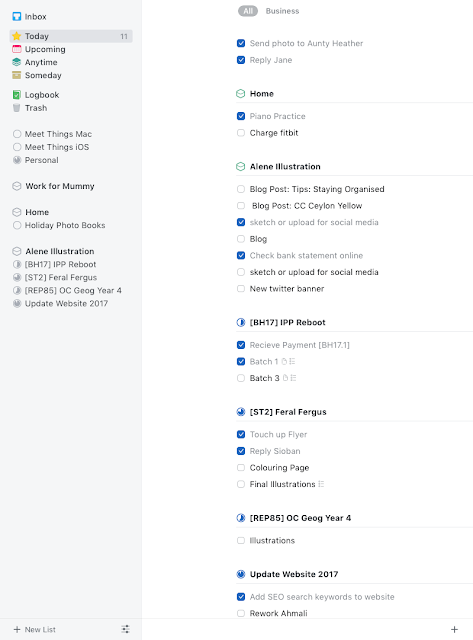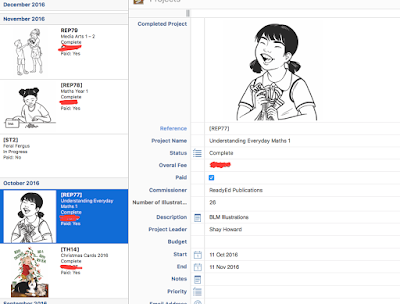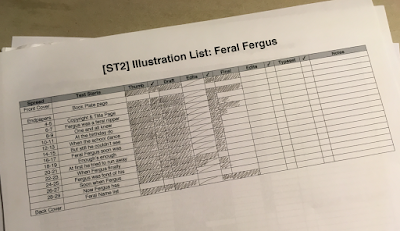So, without further ado: 5 Ways to Stay Organised as an Illustrator
1. Get a To Do App.
I use Things from Cultured Code. It's a Mac and iOS app, so that's no help for all you Windows and Android users out there, but I'm going to tell you about it so you can see how I use it.Here's a look at my to-do list for today. Yeah. I had a busy weekend and I'm paying for it now.

You'll note I have everything organised by area. Right at the top are miscellaneous items that crop up during the day. They need to be done, but don't belong anywhere specific, so I just bung 'em up there. Then I have my Home area, which is usually full of recurring items I've set up - piano practice daily, vacuuming twice a week, my turns to cook dinner, when the dog needs her flea treatment... all that stuff.
And after that, we have business items. Firstly, miscellaneous items - social media, blogging, finances. And after that, items organised by job. I have three jobs on now, plus my website redesign. I create a project for each, and fill that with the various things that need to be done. Every day I check through and move everything that needs to be done today to my 'Today' screen, because that's where I spend most of my time. I don't want to be flicking through different projects, I want everything together in the one place. So anything ongoing is in there (I don't really think I'm going to get the final illustrations for a whole picture book done in one day, I just have it there so I know that is ongoing) and anything that needs to be done today, and anything that crops up throughout the day - maybe I got an email before I got up, or really late at night, and I don't want to reply until I've finished my morning up of tea. I'll put it in there so I don't forget I need to attend to it.
I also use Things to keep track of my invoices. When I send off an invoice, I'll put in a reminder in Things, and set it to pop up in Today on the day it is due. When it does, I can check my cashbook, and if it's been paid, I can just mark it off. If it hasn't been, well, time to send a friendly reminder!
2. Utilise your calendar.
Here's a look at my calendar from a random week, from about midday to midnight. As you can see, I colour-code it. Green is work, blue is everything that isn't work. This way I can see at a glance if I've been managing to get a decent amount of work done or not. If there is too much blue in my calendar, I'm in trouble and need to work harder.
I also code every project with a reference code. I use it in my invoices, my database, my calendar, my folders, my to-do list, everything. If I want to find something I can just search for the code. As numbers and I are not the best of friends, I start each code with the initials of the client, followed by the number of projects I have done with that set of initials. It's unlikely that I'll have two clients with the exact same initials at one and the same time, which means I can tell at a glance which project is which just by this code.
3. Create a project database
I use Tap Forms as my database. I used to use Filemaker's Bento, but they killed it off, so I had to find a replacement.
I keep all relevant information about each project in the database. The code, the project name, the commissioner - everything I need to know. When the project is finished I enter in the final fee and mark off when I have been paid, along with adding a picture to represent the project. You can see the job marked [ST2] has no picture yet, as it's a long project that isn't yet finished. No picture until I'm completely finished, so I don't accidentally think it's all been done! In the sidebar, I can see at a glance which projects are finished, which are paid, etc.
4. Create illustration checklists

For each job I have that is more than just one illustration, I create a checklist. I make a table with every illustration in, and check boxes for thumbnails, (approval), draft, edits, (approval), finals, edits (approval) and typesetting (if required). Then, as I complete each stage, I fill in the box. This way I can see at a glance where I am in a project, and it doesn't feel so overwhelming.
5. Get a yearly planner.
This, I do not do. I just don't have the wall space to put one up, otherwise I would. They're a great way to get an overview of the whole year and see where you are.These are just my tips. There are lots of ways to stay organised, and not all of them work for everyone. Do you have any tips for staying organised? Let me know in the comments if you do!

No comments:
Post a Comment